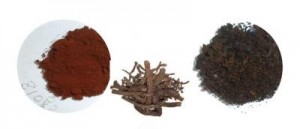It hasn’t happened yet but it looks like the future might hold greener lithium-ion (Li-ion) batteries. According to the Dec. 11, 2012 news release on EurekAlert,
Scientists at Rice University and the City College of New York have discovered that the madder plant, aka Rubia tinctorum, is a good source of purpurin, an organic dye that can be turned into a highly effective, natural cathode for lithium-ion batteries. The plant has been used since ancient times to create dye for fabrics.
…
The goal, according to lead author Arava Leela Mohana Reddy, a research scientist in the Rice lab of materials scientist Pulickel Ajayan, is to create environmentally friendly batteries that solve many of the problems with lithium-ion batteries in use today.

Purpurin, left, extracted from madder root, center, is chemically lithiated, right, for use as an organic cathode in batteries. The material was developed as a less expensive, easier-to-recycle alternative to cobalt oxide cathodes now used in lithium-ion batteries. Credit: Ajayan Lab/Rice University
The Dec. 11, 2012 Rice University news release by Mike Williams, the origin for the one on EurekAlert, describes why the researchers are so interested in a more environmentally-friendly cathode,
While lithium-ion batteries have become standard in conventional electronics since their commercial introduction in 1991, the rechargeable units remain costly to manufacture, Reddy said. “They’re not environmentally friendly. They use cathodes of lithium cobalt oxide, which are very expensive. You have to mine the cobalt metal and manufacture the cathodes in a high-temperature environment. There are a lot of costs.
“And then, recycling is a big issue,” he said. “In 2010, almost 10 billion lithium-ion batteries had to be recycled, which uses a lot of energy. Extracting cobalt from the batteries is an expensive process.”
Reddy and his colleagues came across purpurin while testing a number of organic molecules for their ability to electrochemically interact with lithium and found purpurin most amenable to binding lithium ions. With the addition of 20 percent carbon to add conductivity, the team built a half-battery cell with a capacity of 90 milliamp hours per gram after 50 charge/discharge cycles. The cathodes can be made at room temperature, he said.
“It’s a new mechanism we are proposing with this paper, and the chemistry is really simple,” Reddy said. He suggested agricultural waste may be a source of purpurin, as may other suitable molecules, which makes the process even more economical.
Innovation in the battery space is needed to satisfy future demands and counter environmental issues like waste management, “and hence we are quite fascinated by the ability to develop alternative electrode technologies to replace conventional inorganic materials in lithium-ion batteries,” said Ajayan, Rice’s Benjamin M. and Mary Greenwood Anderson Professor in Mechanical Engineering and Materials Science and of chemistry.
“We’re interested in developing value-added chemicals, products and materials from renewable feedstocks as a sustainable technology platform,” said co-lead author George John, a professor of chemistry at the City College of New York-CUNY and an expert on bio-based materials and green chemistry. “The point has been to understand the chemistry between lithium ions and the organic molecules. Now that we have that proper understanding, we can tap other molecules and improve capacity.”
For anyone who’s interested, you can read the researchers’ article (open access),
Lithium storage mechanisms in purpurin based organic lithium ion battery electrodes by Arava Leela Mohana Reddy, Subbiah Nagarajan, Porramate Chumyim, Sanketh R. Gowda, Padmanava Pradhan, Swapnil R. Jadhav, Madan Dubey, George John & Pulickel M. Ajayan in Scientific Reports 2 Article number: 960 doi:10.1038/srep00960
You might also want to check out Dexter Johnson’s Nov. 26, 2012 posting (on Nanoclast, an IEEE [Institute of Electrical and Electronics Engineers] blog)where he mentions a technical deficiency (recharging becomes increasingly difficult) with the current Li-ion batteries in the context of his description of a new imaging technique.